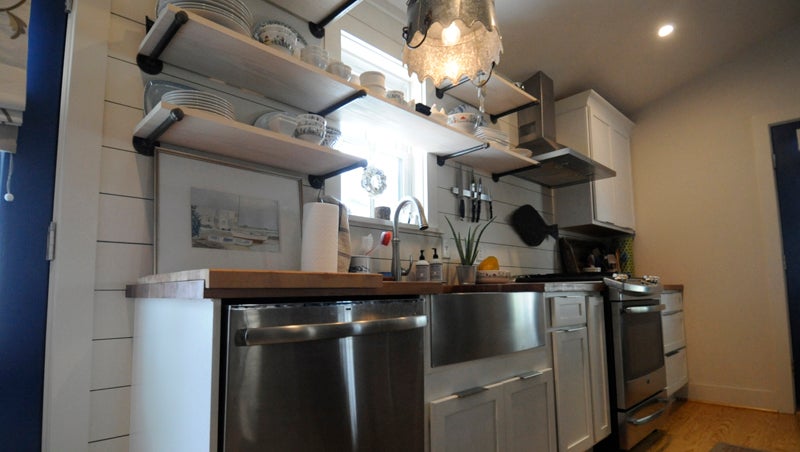Coastal cottage renovation adds neighborhood character
Published 6:22 pm Thursday, May 24, 2018

- GOOD NEIGHBOR: The latest, and last, Terrell Award was given to Bunny Wayt, owner of a cottage on Water Street. The property was completely gutted and renovated, with every effort made to blend into the surrounding structures both new and old. (Vail Stewart Rumley/Daily News)
Nail guns hammer away. The hum of a backhoe drowns out music from a construction worker’s radio. Between Moss Landing Harbor Homes and new construction across the street, the development of Water Street is full speed ahead.
The new construction catches the eye, but amidst the structures that almost appear to spring up overnight is a cottage that could easily be overlooked. But this cottage is making its own small statement, and it’s one that spoke to City of Washington community development planner Emily Rebert and local realtor and historic preservation supporter Scott Campbell, organizers of the Rena K. Terrell Awards.
Bunny Wayt has been awarded the Terrell Award in the “Good Neighbor” category, for not only rescuing the Water Street cottage but renovating it to reflect its neighbors, both old and new.

OPEN SPACES: Two windowed doors allow light in and exit out onto a small front porch that has a water view from the north side of Water Street. In addition to tearing out walls to create an open living/kitchen area, the ceiling was also removed and vaulted to provide an even greater sense of space. (Vail Stewart Rumley/Daily News)
Named for one of Washington’s founding historic preservationists, in 2015, Rebert and Campbell revived the annual awards for property owners who make the extra effort to preserve history, with awards in four categories: Best Residential Rehab, Best Commercial Rehab, the Good Neighbor Award and Stewardship Award.
Wayt’s home is located in the historic district but it’s not a historic structure; in fact, it had a way to go before hitting the benchmark that would allow it to even be considered a contributing structure, or a structure that adds to the historical integrity of the district.
“If a house reaches 50 years old and hasn’t had any major changes done, it becomes a contributing structure. For this house, it would have been another 10 to 15 years, and it would have fallen down by then,” Rebert said.

NAUTICAL: A shiplap wall backs open shelves and appliances in the kitchen area adding to the home’s coastal feel. (Vail Rumley/Washington Daily News)
This particular property, however, has an interesting history nonetheless, because it was constructed by students taking a Washington High School shop class.
“They built houses around town that they could get done in a semester or a school year, and this one was done in 1975. So that explained why the windows were all different sizes because they were working with donated materials,” Wayt said.
When Wayt purchased the property, the 960 square feet of small rooms had seen their share of wear and tear, as it’d been a rental property for many years.
“I had people tell me to tear it down and build new,” she said.
But once the decades-old carpet was pulled up to reveal hardwood floors, Wayt was determined to renovate rather than rebuild. Major changes were in its future, however.
The interior was gutted down to bare studs, and the home’s entire orientation was switched from facing Academy Street to facing Water Street. The back of the house became home to two bedrooms and a bath; the front, an open room where the kitchen and living area share space. Above that, the ceiling was removed and vaulted and a porch added to “new” front of the house on Water Street. Wayt chose to keep the hardwood floors as is, simply filling in the gaps where walls had been — the flooring an architectural element defining what’s new and what’s old.

ALWAYS A VIEW: Situated on the corner of Water and Academy streets, the view from the porch is straight down Academy Street to the Pamlico River. (Vail Stewart Rumley/Daily News)
“It contributes to the story of the house. It really adds to the character,” Rebert said.
It’s also an example of sustainability in that Wayt chose not to increase the square footage of the house by adding a second floor, Rebert said.
“It’s nice to see a variety. We’re building these larger houses in Moss Landing, and it’s good to have some variation,” Rebert said.
“It certainly stays in character for what the neighborhood has been and is becoming,” Campbell said. “This could actually become a model for similar properties that have no fenestrations of value anymore and are completely slapped together.”
For Wayt, its cozy size, its low utility bills, its the view from the front porch down Academy Street all the way to the river adds up to home.
“It’s perfect for me,” Wayt said.





